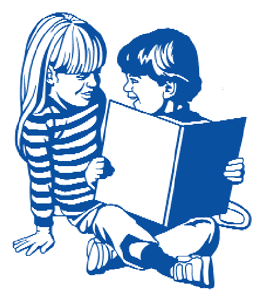Great Books: Why Parents Should Read Aloud to Their Children
By Dr. Michael Platt
Printed in Practical Homeschooling #12, 1996.
 Michael Platt meets Babar, and finds a world of wonder in simply reading aloud to the little ones.
Michael Platt meets Babar, and finds a world of wonder in simply reading aloud to the little ones.

|
 |
The other night at a birthday party, I happened to mention Babar the elephant, who supplied my childhood with happiness and touches of suffering, such as his mother's death. "Who is Babar?" someone asked. The occasion was festive, spirits light-hearted, and the evening young; so I brought out the tiny copy of Babar the King that I carry in my satchel, along with the Gospels and the American founding documents, and I handed it to him.
As my questioner looked at it in silence, he began to smile. Soon an almost giddy happiness lighted up his face. He then opened his mouth and said, "This is giving me shivers. I must have read this. I recognize these pictures. I have not thought of this since I was a child." Page after page he turned, exclaiming in the same vein. "Yes, there's the elephant in the elevator." "Yes, there's the elephant doing calisthenics with the old lady." "Yes, here is the elephant in the palisserie." And, "Here is Babar becoming King." He was having such an experience, such a rapturous recapturing of time past, and such a recognition of himself, that we all fell silent and let him go on oblivious of us and the silence surrounding his sighs of happiness.
A thrill akin to what an atheist experiences upon learning that the Lord has protected him, yea from his own atheism, all those years of his murmuring and waywardness, until he could see the loving light, was breaking over our friend.
Why is it good to read aloud to your children? Well, so that when they grow up they can have such happiness as my friend was having; so that they in turn can pass such happiness on to their children, world without end.
Let me explain. Nothing in human life is so fixed that it cannot be undone. You can stray from a good childhood. You can overcome a bad childhood. Free will exists. Nevertheless, how much better it is to begin well! But our beginnings are not our own. What is good in them comes from others. From our family, from nature, from nature's God. Thus throughout nature, it is the natural duty of parents not merely to procreate offspring, but to pass to them the blessings they have received. In short, to make the childhood good. This homeschoolers know.
The good things that fill your imagination when you are young strengthen your soul with two mighty things: the aspiration that will carry you to high endeavor and the comfort that will keep suffering from consuming you. As it happens, I can illustrate these twin goods from Babar. When our boy, Anton, was an infant he fretted much when being changed. So one day I put the picture on the cover of Babar the King in front of him. Focusing through his tears upon Babar mounted on horseback, banner unfurling, he gradually quieted. Ever since then, this picture of chivalric virtue had the same effect.
Was it the dim sense that such powers of good as this fictional elephant commands are somewhere in the real universe at this moment on the way to help him? Or was it the image of virtue overcoming adversity, pain, and discontent, of Babar saying, "I shall overcome evil, you can do it, too," that strengthened our boy? I rather think it was the comfort that calmed infant Anton, but now that he is six it is the lesson that adversity can be overcome that appeals.
Babar is both a rescuer and a model of virtue. He is both on the way to help you and a hero who shows you how to help yourself. Read through the stories; all acknowledge that we are vulnerable, threatened, prone to error - that mothers die, snakes bite, baby carriages head for precipices when we get distracted - and all affirm that confidence, firmness, and sagacity may prevail, as King Babar does.
Obviously the Babar stories honor families. Many of them do so by setting out on adventures and by ending at home. One family took this to an interesting length. After reading Babar and other wonderful children's stories, of Heidi, of the Pied Piper, of Pinocchio, the ones by Hans Christian Anderson, etc., Christina Hardyment and her family spent a summer traveling around Europe to the scenes where these stories take place. That wonderful summer (so different from going to Disney!) is recorded in Heidi's Alp (Atlantic Monthly, 1987). It is from that book, and Ann Hildebrand's book Jean and Laurent de Brunhoff (Twayne, 1991) that I learned how the Babar stories came to be, and thus another reason for reading together as a family.
One day Cecile de Brunhoff told the first Babar story. Soon after, Jean, her husband, added pictures. Published, it soon acquired a following. It is good that it did, for Jean caught tuberculosis, and had to leave the family for a sanitarium in Switzerland. Far away and ill, he stayed in touch with his family through his work on the later Babar stories. He stayed in fatherly contact with the children especially through the stories themselves, in which Babar, though early orphaned, grows up to be an exemplary father, which is one of the enduring sources of his appeal to children and their parents. These wonderful stories began in a family and they bound that family together even as members were passing away. They still do, for although Laurent de Brunhoff's continuations may not have quite the same qualities of his father's work, they have always honored them. How to honor thy father and also to thine own self be true has been the story of the younger de Brunhoff's life.
Babar protects his family. The Babar stories can nurture, protect, and even in some sense rescue families which are infected with the world's disdain for family commitment and family roles.
Even more, we can also take hero and book as a model to emulate.
What a wonderful thing it would be for all parents to make up stories and share them with their children the way the de Brunhoffs have! I've tried. Bozeman is a black horse, 5 inches tall, who came up to me in a cafe in Montana, in a town named for him, and asked to join our family, whereupon I spotted him with white-out in accord with Anton's desire, and sent him back to Vermont. When we moved down to Houston for a term, we left many things. One day Anton and Sally missed them, and I asked, "Don't you think Bozeman might bring them when the snow clears?" It was soon acknowledged that if anybody could do it, Bozeman would. And sure enough, soon a postcard from Granna in Virginia arrived, saying Bozeman had passed through, pulling a Connestoga wagon with Buffalo helping, too. Another card from the staff of the Casey Jones motel in Jackson, Tennessee (a good Christian establishment), tracked their progress, and sure enough as April was coming to an end, in came Bozeman with the things left behind and some cowboy boots for Sally picked up at the Texas border.
 Well, we like this story, but maybe that only illustrates that not all family stories travel outside the family, which is no reason not to keep telling them in the family.
Well, we like this story, but maybe that only illustrates that not all family stories travel outside the family, which is no reason not to keep telling them in the family.
Few of us have the gifts of Jean de Brunhoff, but we could at least retell the great stories we know. Even a well-known story becomes special when retold by your mother or father. My daughters, Heather and Derry, once asked me "What do you do?" I replied, "I teach Shakespeare," which I could see did not illuminate things very much. So I launched into a retelling of Hamlet, a story which asks the question, "Should you always obey your father?" and King Lear, a story which asks the question, "Are eldest daughters always the worst?" and the question, "Is it wrong to ask 'Do you love me?'"
Be it The Three Bears or the three monsters in Beowulf, we can always retell the great stories we know.
Moreover, we parents have stories that no one else can tell our children. We and we alone can tell the stories of our own childhood. "When I was a little girl, I . . ." We and we alone can tell them the stories of their own infancy and childhood. "When you were a baby . . ." and "The day you were born . . ." When they are older, we can tell them the stories of our courtship. "When I first met your Daddy . . ." These, too, are to be shared and no one else can do this for them.
No one else can do this for us, either. Families are, to an important degree, people who share stories. Consider what a gift Carrie Young's mother gave her in the story "The Wedding Dress" which she has given to us now, in a volume of the same name (Laurel, 1992). Countries are a people made by a shared story. For us Americans the story is made up of the principles of the Declaration, the compromise of the Constitution, the Civil War, the settling up from sea to shining sea, and the burden of world responsibilities. The souls that make up countries and families are also made of stories. So let the stories be good ones.